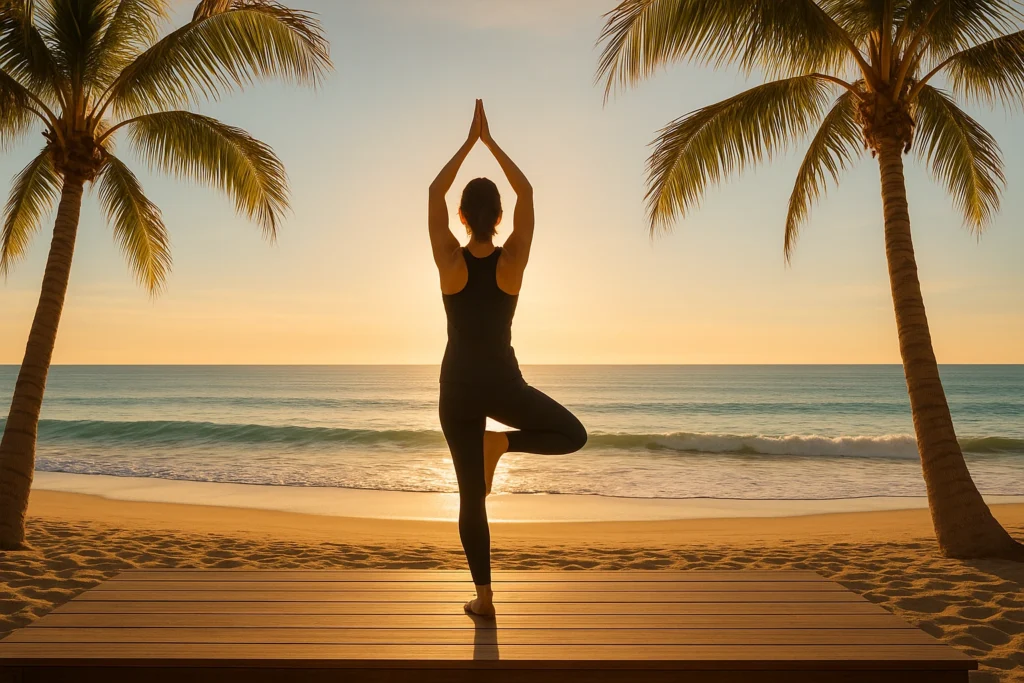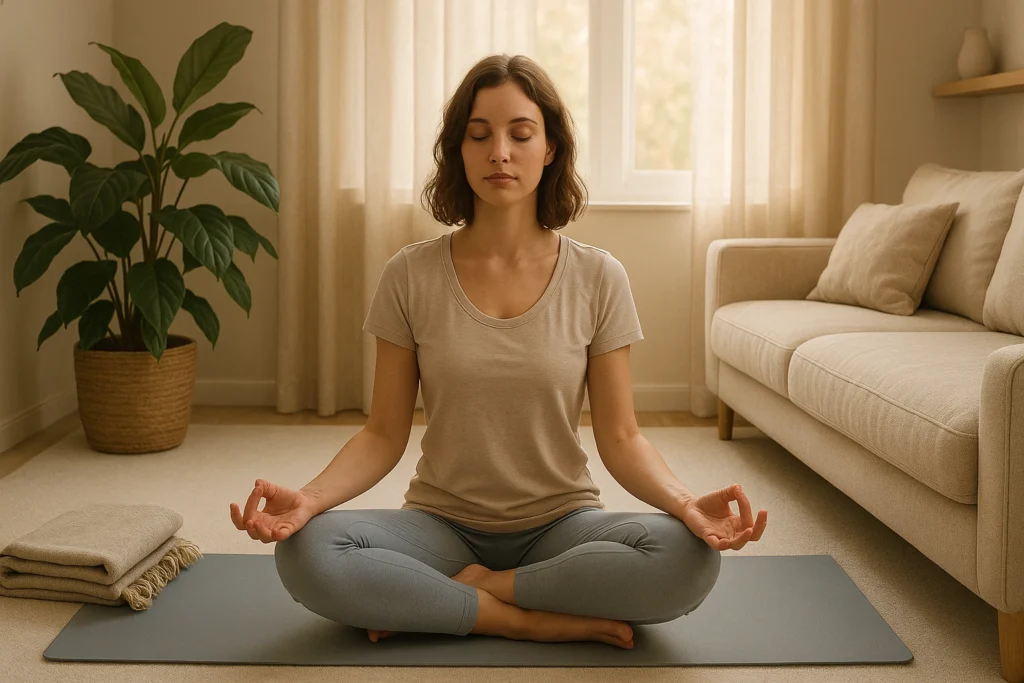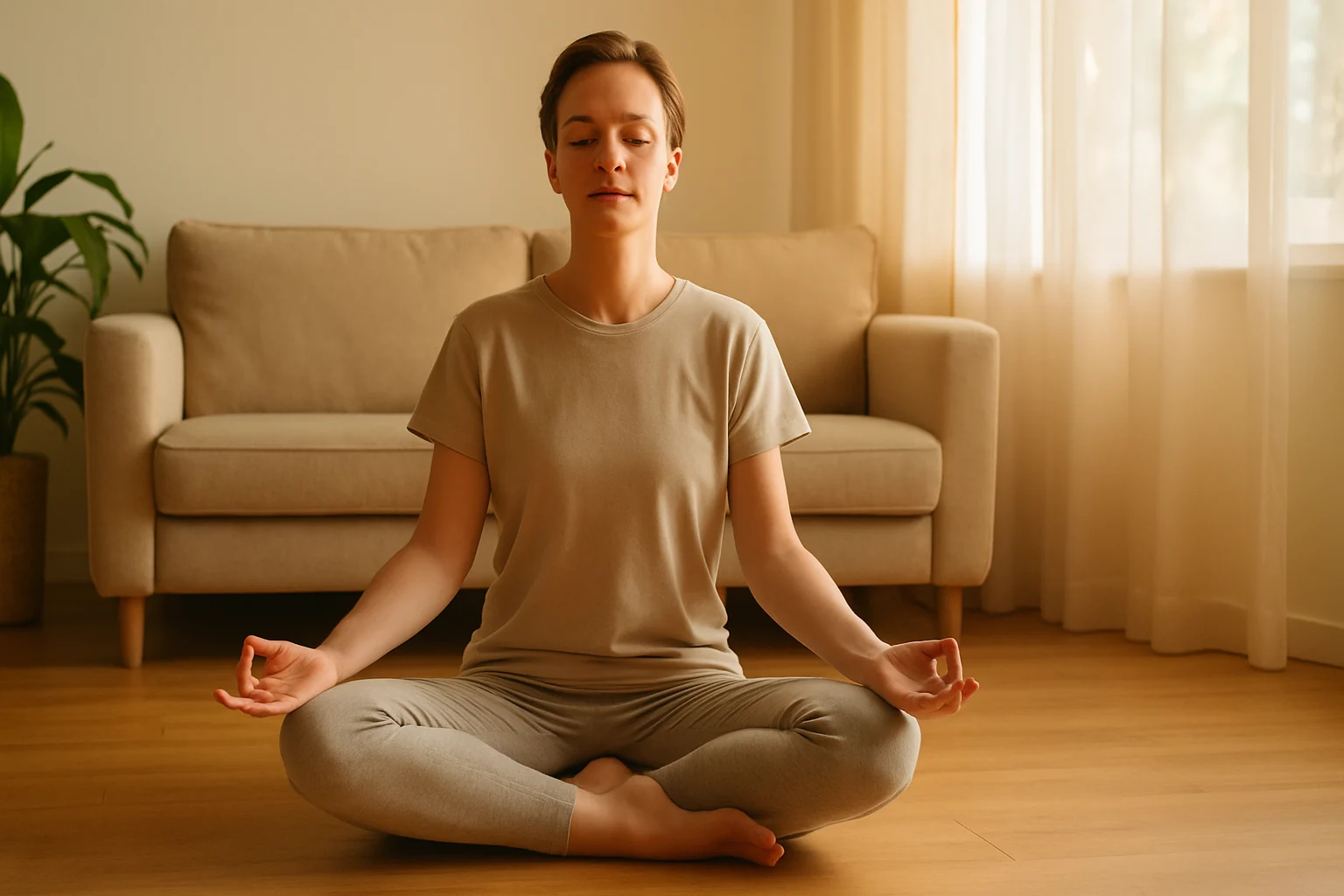
Imagine unwinding in your living room with yoga at home no equipment—no need for gym trips or costly props. Whether you’re a senior looking for gentle stretches, a beginner dipping your toes into yoga, or simply seeking some calm, this guide has a full yoga routine tailored for 2025. All you need is a small corner and 15 minutes to feel refreshed and revitalized. Excited to get started? Explore our yoga flexibility guide for more insights. Let’s dive in!
Start Your Yoga Journey!Table of Contents
- Benefits of Yoga at Home No Equipment
- Beginner Tips: Yoga at Home No Equipment
- Gentle Yoga for Seniors and Back Comfort
- Your Yoga at Home No Equipment Routine: Step-by-Step
- Staying Motivated with Your Yoga Practice
- Alo Moves for At-Home Beginners
- Interactive Check-In: Ready for Home Yoga?
- Frequently Asked Questions
- Conclusion: Embrace Your Equipment-Free Yoga Journey
Benefits of Yoga at Home No Equipment
Starting yoga at home can feel a little intimidating—there’s so much buzz about studios and fancy gear. The good news? A home practice skips the hassle. It’s simple, flexible, and can support both your body and your mind. Want to ease stress? Pair this routine with yoga and breathwork for stress relief. Here’s why it helps:
- Anytime, Anywhere: Practice wherever you are, using nothing but your body.
- Budget-Friendly: Skip the mats, blocks, straps, or expensive memberships.
- Fits Your Schedule: Slip your practice into your day without stepping out.
- Great for Newbies: Start with simple poses to build a solid foundation.
- Customizable: Tweak poses to match your comfort and needs.
Beyond the physical perks, yoga at home can lift mood and support emotional well-being. Some research suggests regular practice may help reduce anxiety. I felt more calm after a week of simple flows at home, and you might too.
This post has affiliate links. We may earn a commission. Learn more.
“Yoga is a light, which once lit, will never dim. The better your practice, the brighter your flame.” – B.K.S. Iyengar
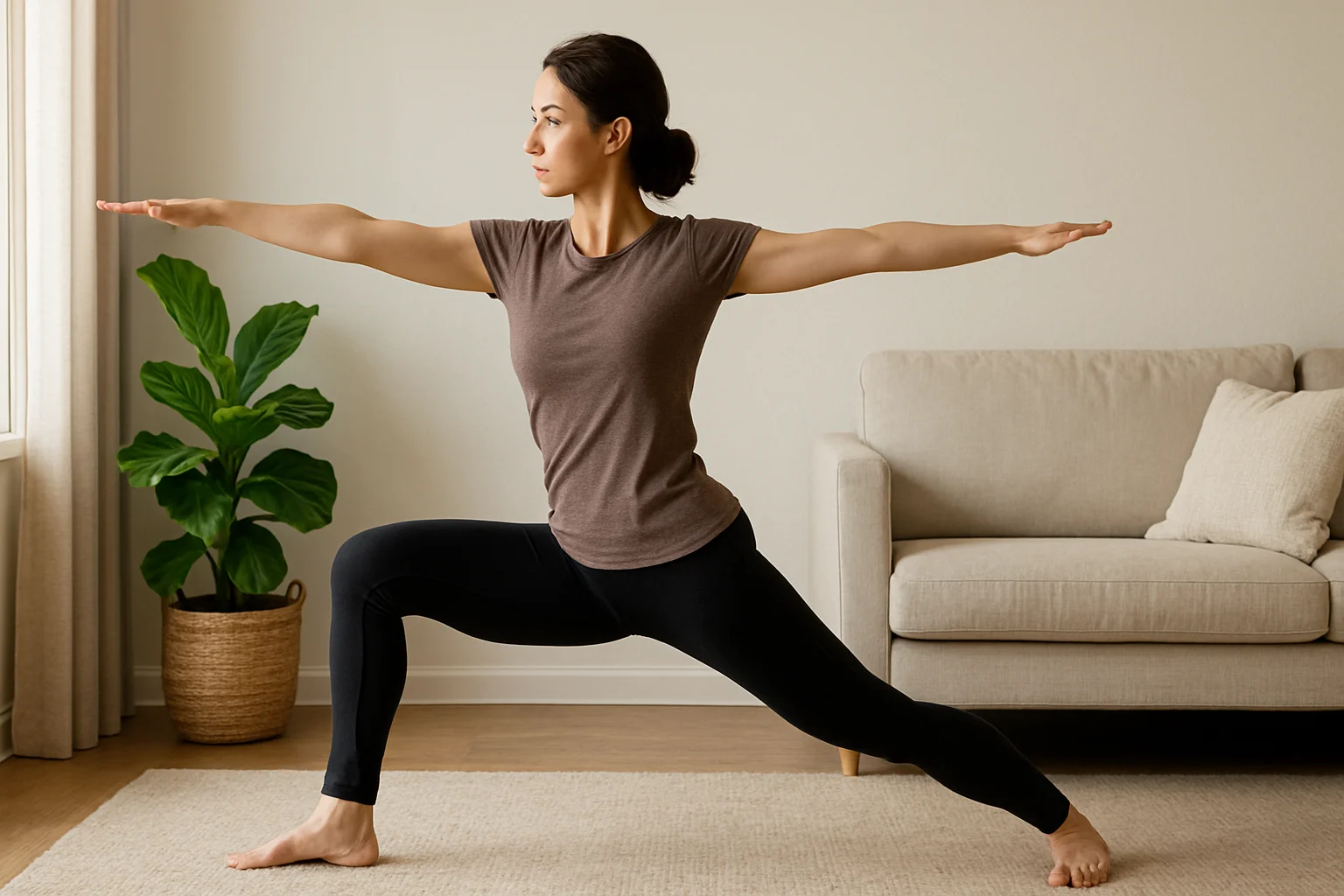
Beginner Tips: Yoga at Home No Equipment
Beginner Home Yoga: Overcoming Challenges
When I first gave yoga at home a go, I was a bit nervous and wondered if I’d find the time. Totally normal to feel that! Easing in with short sessions in a cozy nook at home made it feel doable. Joining online groups, like Alo Moves’ forums, kept my spirits high and gave me a sense of community. Want to take it further? Check out the mindful movement benefits of yoga for some extra inspiration.
Even 10 minutes most days can change how you feel. To make yoga without equipment stick:
- Start small: Begin with 10–15 minutes and add time as it feels right.
- Set a schedule: Pick a consistent time—morning or before bed both work.
- Create a space: Clear a quiet spot where you won’t be interrupted.
- Be patient: Habits take time; if you miss a day, simply pick it back up.
- Find a partner: Share progress with a friend to stay accountable.
Gentle Yoga for Seniors and Back Comfort
This routine is designed for seniors and anyone dealing with back discomfort. The focus is on easy, steady movements that build core support, encourage upright posture, and ease tension. Want more options? Explore gentle yoga tailored for seniors to find poses that pair well with this practice. Moves like Bridge often leave me feeling steadier and a bit more comfortable.
Key Considerations for Safe Practice
- Consult your doctor: Check in with a professional if you have health concerns.
- Warm-up: Prepare your muscles to reduce injury risk.
- Alignment: Focus on comfortable form to stay safe.
- Breathing: Inhale through your nose and exhale slowly.
- Listen to your body: Stop if you feel pain.
Your Yoga at Home No Equipment Routine: Step-by-Step
This routine blends flexibility, strength, and relaxation. Follow along and tweak anything so it fits what feels good for you.
Warm-Up (5 Minutes)
- Neck rolls: Gently circle your head in both directions. (1 min)
- Shoulder rolls: Roll shoulders forward, then back. (1 min)
- Arm circles: Extend your arms and trace small circles. (1 min)
- Wrist & ankle circles: Rotate both ways. (2 min)
Standing Poses (15 Minutes)
- Mountain Pose (Tadasana): Stand tall with feet hip-width, lightly engage your core, and lengthen your spine. (1 min)
“Mountain Pose teaches us to root our feet while reaching for the sky.”
- Modification: Widen your stance if that feels steadier.
- Standing Forward Bend (Uttanasana): Bend forward from hips, reach for toes or floor. (2 min)
- Modification: Bend knees or hold shins.
- Warrior II (Virabhadrasana II): Step feet wide, bend right knee over ankle, arms extended. Look over right hand. (2 min/side)
- Modification: Reduce lunge depth; rest back hand on leg.
- Triangle Pose (Trikonasana): From Warrior II, straighten right leg, reach right hand to ankle or shin, left arm up. (2 min/side)
- Modification: Rest hand on thigh.
- Tree Pose (Vrksasana): Place right foot on left thigh, hands at chest or overhead. (1 min/side)
- Modification: Place foot on calf or use a chair for balance.
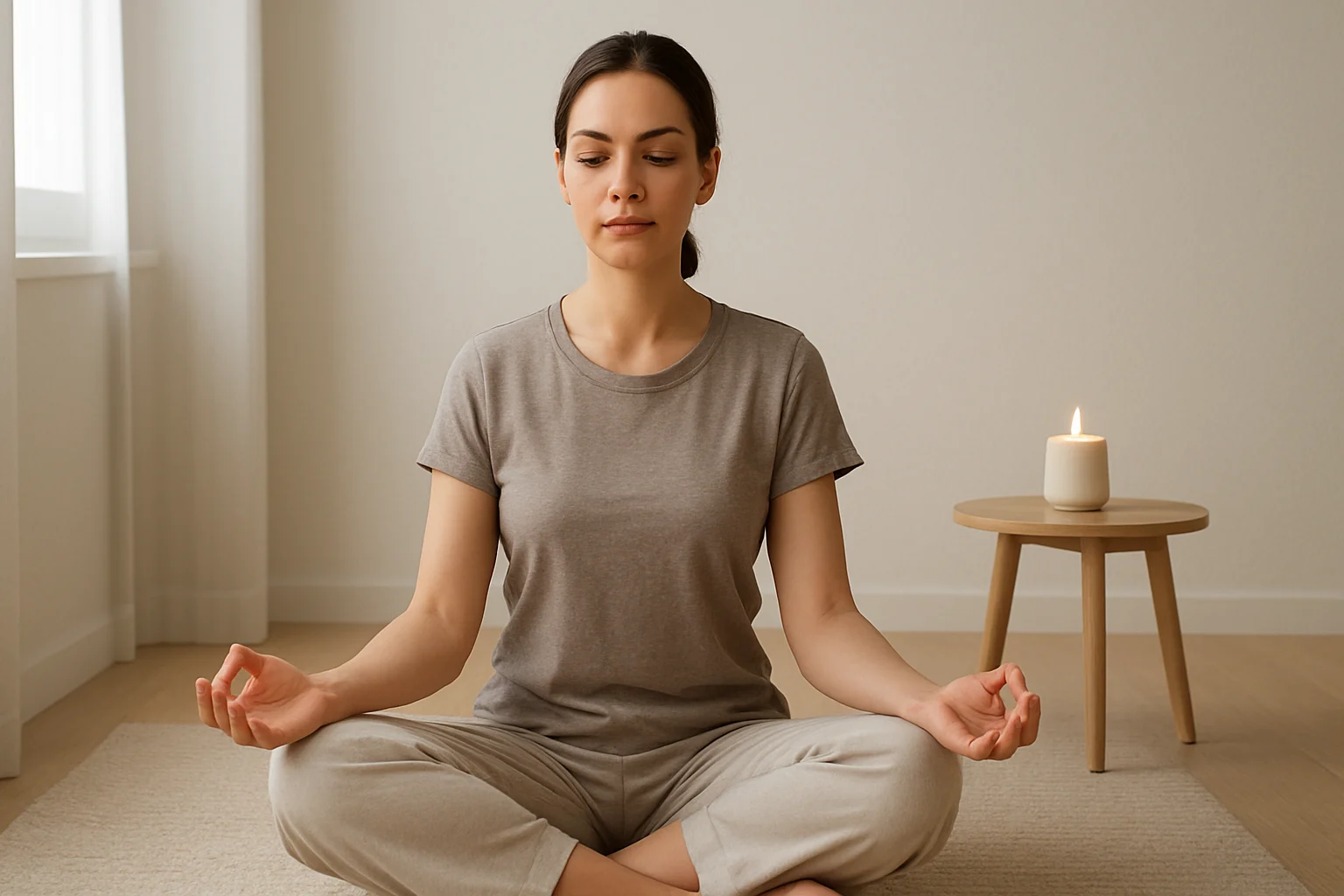
Seated Poses (15 Minutes)
- Staff Pose (Dandasana): Sit with legs extended, feet flexed, hands by hips. (1 min)
- Modification: Sit on a folded blanket.
- Seated Forward Bend (Paschimottanasana): Bend forward, reach for toes or shins. (2 min)
- Modification: Bend knees or use a strap.
- Easy Pose (Sukhasana): Sit cross-legged, hands on knees. (2 min)
- Modification: Sit on a cushion.
- Spinal Twist (Ardha Matsyendrasana): Twist torso right, right hand behind, left hand on right knee. (2 min/side)
- Modification: Keep one leg extended.
- Butterfly Pose (Baddha Konasana): Soles together, knees open, hold feet. (2 min)
- Modification: Support knees with cushions.
Lying Down Poses (15 Minutes)
- Bridge Pose (Setu Bandhasana): Lie on back, knees bent, lift hips, clasp hands underneath. (2 min)
- Modification: Place a block under sacrum.
- Knees-to-Chest Pose (Apanasana): Hug knees to chest, rock side to side. (2 min)
- Modification: Keep one leg extended.
- Reclining Twist (Supta Matsyendrasana): Knees to chest, let them fall right, arms out. (2 min/side)
- Modification: Support knees with a pillow.
- Corpse Pose (Savasana): Lie flat, arms at sides, relax fully. (5 min)
“Savasana integrates the benefits of your practice.”
Cool-Down (5 Minutes)
- Deep Breathing: Inhale through nose, exhale through mouth. (2 min)
- Gentle Stretching: Stretch arms, legs, and torso. (3 min)
Staying Motivated with Your Yoga Practice
Sticking with a simple, equipment-free home routine often makes the difference. Tight on time? Pair this routine with quick desk yoga for posture relief to keep things fresh. Here’s how to stay pumped about your practice:
- Set Achievable Goals: Shoot for 3–5 sessions a week, starting with just 10–15 minutes.
- Mix It Up: Experiment with different flows to keep your practice lively and fun.
- Log Your Journey: Note how you feel in a journal or app to track your progress.
- Treat yourself: Celebrate with a relaxing bath or a favorite snack.
- Create a vibe: Soft music or a candle can make practice feel special—experiment with playlists or dim lighting to find what helps you show up.
- Keep going: Miss a day? No worries—just jump back in.
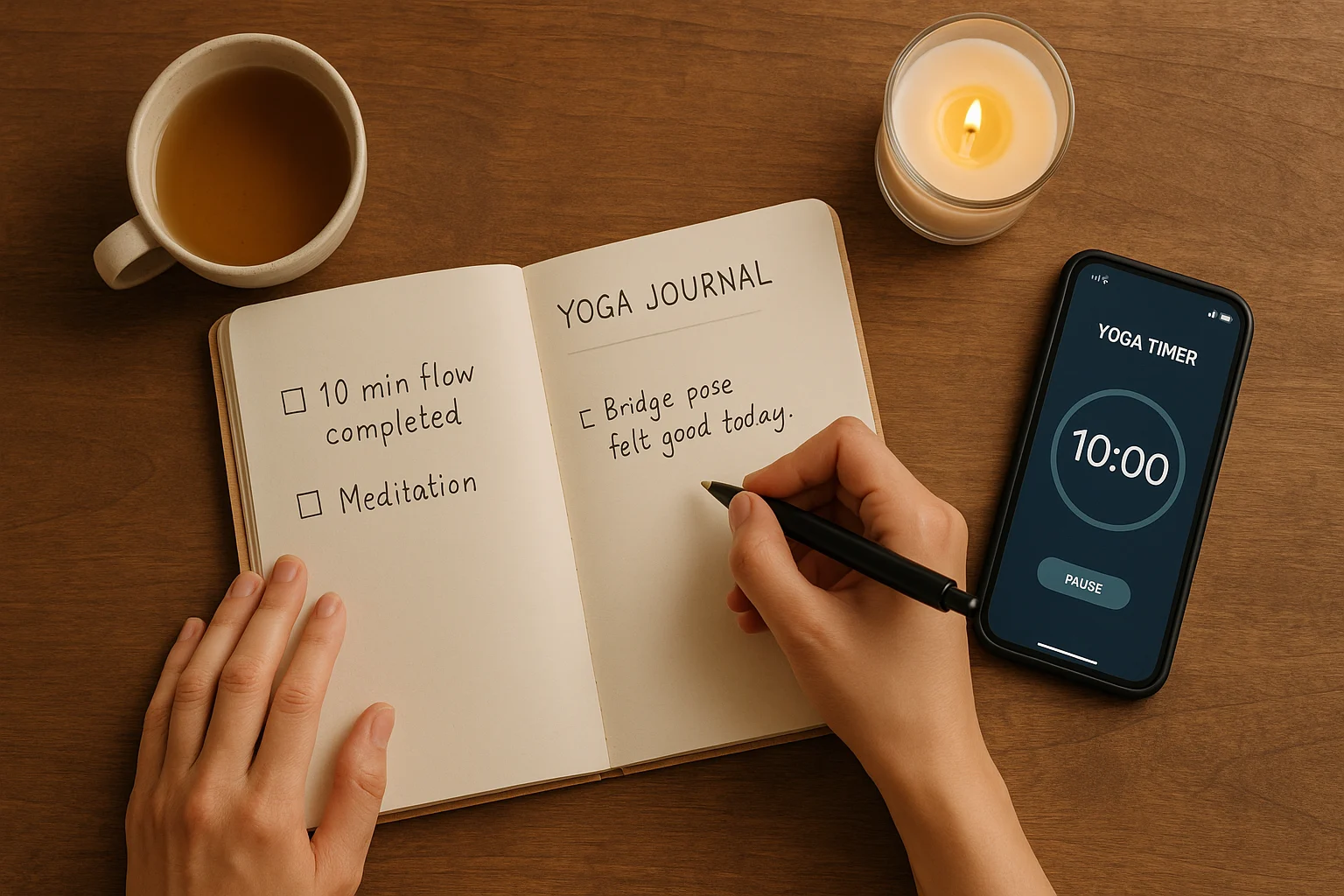
Alo Moves for Beginner Home Yoga
For guided sessions, check out Alo Moves’ free trial. Their equipment-free flows are perfect for beginners practicing at home. Here’s why it helps:
- Variety: Plenty of classes for every level.
- Expert instructors: Learn from experienced teachers.
- Mobile app: Practice wherever you are.
- Filters: Sort by length, intensity, or focus.
- No-Mat Flows: Ideal for small spaces.
- Beginner Series: Learn yoga fundamentals.
“Alo Moves enhances your at-home yoga practice with variety.”
Interactive Check-In: Ready for Home Yoga?
Assess your readiness to start a beginner-friendly home yoga routine with this quick tool, designed for practicing yoga in your own space.
Check Your Yoga Readiness
Answer two questions to see if you’re ready for yoga without equipment.
Frequently Asked Questions
Conclusion: Embrace Your Equipment-Free Yoga Journey
Yoga may support physical and mental well-being. If you follow this beginner home yoga routine 3–5 times a week, you can gradually build strength and a sense of calm at your own pace. Listen to your body, modify as needed, and stay patient. For extra guidance, try Alo Moves’ free trial. Always consult a healthcare professional before starting any new exercise routine, especially if you have pre-existing conditions. Namaste! 🧘♀️✨
